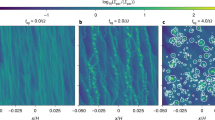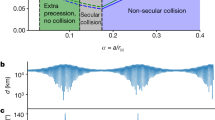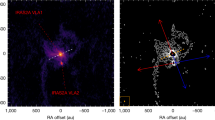Abstract
Recent observations1,2,3,4,5,6,7,8 have revealed that an unexpectedly high fraction—a few per cent—of the trans-Neptunian objects (TNOs) that inhabit the Kuiper belt are binaries. The components have roughly equal masses, with very eccentric orbits that are wider than a hundred times the radius of the primary. Standard theories of binary asteroid formation tend to produce close binaries with circular orbits, so two models have been proposed9,10 to explain the unique characteristics of the TNOs. Both models, however, require extreme assumptions regarding the size distribution of the TNOs. Here we report a mechanism that is capable of producing binary TNOs with the observed properties during the early stages of their formation and growth. The only required assumption is that the TNOs were initially formed through gravitational instabilities11 in the protoplanetary dust disk. The basis of the mechanism is an exchange reaction in which a binary whose primary component is much more massive than the secondary interacts with a third body, whose mass is comparable to that of the primary. The low-mass secondary component is ejected and replaced by the third body in a wide but eccentric orbit.
This is a preview of subscription content, access via your institution
Access options
Subscribe to this journal
Receive 51 print issues and online access
$199.00 per year
only $3.90 per issue
Buy this article
- Purchase on Springer Link
- Instant access to full article PDF
Prices may be subject to local taxes which are calculated during checkout




Similar content being viewed by others
References
Burns, J. A. Two Bodies Are Better Than One. Science 297, 942–943 (2002)
Veillet, C. et al. The binary Kuiper-belt object 1998 WW 31. Nature 416, 711–713 (2002)
Margot, J.-L. Worlds of mutual motion. Nature 416, 694–695 (2002)
Noll, K. S. et al. Detection of two binary trans-Neptunian objects, 1997 CQ29 and 2000 CF105, with the Hubble Space Telescope. Astron. J. 124, 3424–3429 (2002)
Schaller, E. L. & Brown, M. E. A deep Keck search for binary Kuiper Belt objects. DPS 35th Meeting Abstr. no. 39.20 (American Astronomical Society, Washington DC, 2003)
Noll, K. S. et al. Discovery of transneptunian binaries with HST. DPS 35th Meeting Abstr. no. 49.70 (American Astronomical Society, Washington DC, 2003)
Noll, K. S. et al. 2001 QC_298. IAU Circ. No. 8034 (2002)
Noll, K. S. & Stephens, D. C. 1999 RZ_253. IAU Circ. No. 8143 (2003)
Weidenschilling, S. J. On the origin of binary transneptunian objects. Icarus 160, 212–215 (2002)
Goldreich, P., Lithwick, Y. & Sari, R. Formation of Kuiper-belt binaries by dynamical friction and three-body encounters. Nature 420, 643–646 (2002)
Goldreich, P. & Ward, W. R. The formation of planetesimals. Astrophys. J. 183, 1051–1062 (1973)
Merline, W. J. et al. in Asteroids III (eds Bottke, W. F., Cellino, A., Paolicchi, P. & Binzel, R. P.) 273–287, (Lunar and Planetary Institute, Houston, 2003)
Hartmann, W. K. & Davis, D. R. Satellite-sized planetesimals and lunar origin. Icarus 24, 504–515 (1975)
Kokubo, E., Ida, S. & Makino, J. Evolution of a circumterrestrial disk and formation of a single moon. Icarus 148, 419–436 (2000)
Durda, D. D., Bottke, W. F., Asphaug, E. & Richardson, D. C. The formation of asteroid satellites: Numerical simulations using SPH and N-body models. Bull. Am. Astron. Soc. 33, 1134 (2001)
Durda, D. D. et al. The formation of asteroid satellites in catastrophic impacts: Results from numerical simulations. Lunar Planet Sci. XXXIV Abstr. no. 1943 (Lunar and Planetary Institute, Houston, 2003)
Fabian, A. C., Pringle, J. E. & Rees, M. J. Tidal capture formation of binary systems and X-ray sources in globular clusters. Mon. Not. R. Astron. Soc. 172, 15–18 (1975)
Heggie, D. C. Binary evolution in stellar dynamics. Mon. Not. R. Astron. Soc. 173, 729–787 (1975)
Kokubo, E. & Ida, S. Oligarchic growth of protoplanets. Icarus 131, 171–178 (1998)
Makino, J., Fukushige, T., Funato, Y. & Kokubo, E. On the mass distribution of planetesimals in the early runaway stage. New Astron. 3, 411–416 (1998)
Wetherill, G. W. Formation of the earth. Annu. Rev. Earth Planet. Sci. 18, 205–256 (1990)
Kenyon, S. J. & Luu, J. X. Accretion in the Early Kuiper Belt. I. Coagulation and velocity evolution. Astron. J. 115, 2125–2160 (1998)
Spitzer, L. Dynamical evolution of globular clusters. (Princeton Univ. Press, Princeton, NJ, 1987)
Hut, P. Hard binary-single star scattering cross sections for equal masses. Astrophys. J. Suppl. 55, 301–317 (1984)
Hut, P. & Inagaki, S. Globular cluster evolution with finite-size stars—Cross sections and reaction rates. Astrophys. J. 298, 502–520 (1985)
Heggie, D. C. & Hut, P. The Gravitational Million-Body Problem Ch. 23 (Cambridge Univ. Press, Cambridge, 2003)
McMillan, S. & Hut, P. Binary-single-star scattering. VI. Automatic determination of interaction cross sections. Astrophys. J. 467, 348–358 (1996)
Acknowledgements
We acknowledge comments on our manuscript by P. Goldreich, R. Rafikov, R. Sari, K. S. Noll and D. Durda.
Author information
Authors and Affiliations
Corresponding author
Ethics declarations
Competing interests
The authors declare that they have no competing financial interests.
Rights and permissions
About this article
Cite this article
Funato, Y., Makino, J., Hut, P. et al. The formation of Kuiper-belt binaries through exchange reactions. Nature 427, 518–520 (2004). https://doi.org/10.1038/nature02323
Received:
Accepted:
Issue Date:
DOI: https://doi.org/10.1038/nature02323
This article is cited by
-
The wide-binary origin of (2014) MU69-like Kuiper belt contact binaries
Nature (2020)
-
The New Horizons Kuiper Belt Extended Mission
Space Science Reviews (2018)
-
Formation of the extreme Kuiper-belt binary 2001 QW322 through adiabatic switching of orbital elements
Celestial Mechanics and Dynamical Astronomy (2010)
-
Neptune's capture of its moon Triton in a binary–planet gravitational encounter
Nature (2006)
Comments
By submitting a comment you agree to abide by our Terms and Community Guidelines. If you find something abusive or that does not comply with our terms or guidelines please flag it as inappropriate.



